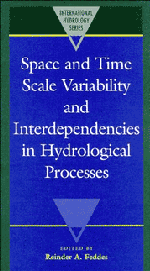Book contents
- Frontmatter
- Contents
- Acknowledgement
- OPENING ADDRESS OF THE FIRST GEORGE KOVACS COLLOQUIUM
- HETEROGENEITY AND SCALING LAND-ATMOSPHERIC WATER AND ENERGY FLUXES IN CLIMATE SYSTEMS
- SCALE PROBLEMS IN SURFACE FLUXES
- REMOTE SENSING – INVERSE MODELLING APPROACH TO DETERMINE LARGE SCALE EFFECTIVE SOIL HYDRAULIC PROPERTIES IN SOIL–VEGETATION–ATMOSPHERE SYSTEMS
- THE IMPORTANCE OF LANDSCAPE POSITION IN SCALING SVAT MODELS TO CATCHMENT SCALE HYDROECOLOGICAL PREDICTION
- THE INFLUENCE OF SUBGRID-SCALE SPATIAL VARIABILITY ON PRECIPITATION AND SOIL MOISTURE IN AN ATMOSPHERIC GCM
- MODELLING THE HYDROLOGICAL RESPONSE TO LARGE SCALE LAND USE CHANGE
- AN APPROACH TO REPRESENT MESOSCALE (SUBGRID-SCALE) FLUXES IN GCMs DEMONSTRATED WITH SIMULATIONS OF LOCAL DEFORESTATION IN AMAZONIA
- A HIERARCHICAL APPROACH TO THE CONNECTION OF GLOBAL HYDROLOGICAL AND ATMOSPHERIC MODELS
- STOCHASTIC DOWNSCALING OF GCM-OUTPUT RESULTS USING ATMOSPHERIC CIRCULATION PATTERNS
- DEPENDENCIES OF SPATIAL VARIABILITY IN FLUVIAL ECOSYSTEMS ON THE TEMPORAL HYDROLOGICAL VARIABILITY
- PROBLEMS AND PROGRESS IN MACROSCALE HYDROLOGICAL MODELLING
- PREDICTABILITY OF THE ATMOSPHERE AND CLIMATE: TOWARDS A DYNAMICAL VIEW
- FROM SCALAR CASCADES TO LIE CASCADES: JOINT MULTIFRACTAL ANALYSIS OF RAIN AND CLOUD PROCESSES
- FRACTALS ET MULTIFRACTALS APPLIQUÉS À L'ÉTUDE DE LA VARIABILITÉ TEMPORELLE DES PRÉCIPITATIONS
THE IMPORTANCE OF LANDSCAPE POSITION IN SCALING SVAT MODELS TO CATCHMENT SCALE HYDROECOLOGICAL PREDICTION
Published online by Cambridge University Press: 05 November 2011
- Frontmatter
- Contents
- Acknowledgement
- OPENING ADDRESS OF THE FIRST GEORGE KOVACS COLLOQUIUM
- HETEROGENEITY AND SCALING LAND-ATMOSPHERIC WATER AND ENERGY FLUXES IN CLIMATE SYSTEMS
- SCALE PROBLEMS IN SURFACE FLUXES
- REMOTE SENSING – INVERSE MODELLING APPROACH TO DETERMINE LARGE SCALE EFFECTIVE SOIL HYDRAULIC PROPERTIES IN SOIL–VEGETATION–ATMOSPHERE SYSTEMS
- THE IMPORTANCE OF LANDSCAPE POSITION IN SCALING SVAT MODELS TO CATCHMENT SCALE HYDROECOLOGICAL PREDICTION
- THE INFLUENCE OF SUBGRID-SCALE SPATIAL VARIABILITY ON PRECIPITATION AND SOIL MOISTURE IN AN ATMOSPHERIC GCM
- MODELLING THE HYDROLOGICAL RESPONSE TO LARGE SCALE LAND USE CHANGE
- AN APPROACH TO REPRESENT MESOSCALE (SUBGRID-SCALE) FLUXES IN GCMs DEMONSTRATED WITH SIMULATIONS OF LOCAL DEFORESTATION IN AMAZONIA
- A HIERARCHICAL APPROACH TO THE CONNECTION OF GLOBAL HYDROLOGICAL AND ATMOSPHERIC MODELS
- STOCHASTIC DOWNSCALING OF GCM-OUTPUT RESULTS USING ATMOSPHERIC CIRCULATION PATTERNS
- DEPENDENCIES OF SPATIAL VARIABILITY IN FLUVIAL ECOSYSTEMS ON THE TEMPORAL HYDROLOGICAL VARIABILITY
- PROBLEMS AND PROGRESS IN MACROSCALE HYDROLOGICAL MODELLING
- PREDICTABILITY OF THE ATMOSPHERE AND CLIMATE: TOWARDS A DYNAMICAL VIEW
- FROM SCALAR CASCADES TO LIE CASCADES: JOINT MULTIFRACTAL ANALYSIS OF RAIN AND CLOUD PROCESSES
- FRACTALS ET MULTIFRACTALS APPLIQUÉS À L'ÉTUDE DE LA VARIABILITÉ TEMPORELLE DES PRÉCIPITATIONS
Summary
ABSTRACT Process-based models of soil-vegetation-atmosphere interactions developed for small plots (points) define vertical transfers of water and energy. One can attempt to scale to larger heterogeneous land units by disaggregating the landscape into a set of elements and applying a vertical SVAT model independently to each element (Running et al., 1989; Pierce et al., 1992). Such applications fail to consider lateral transfers. A distributed parameter, three-dimensional SVAT (Topog-IRM) developed by the CSIRO Division of Water Resources (O'Loughlin, 1990; Hatton and Dawes, 1991; Hatton et al., 1992) is used to examine the importance of lateral transfers of water for prediction of water balance components at the small catchment scale.
Simulations are used to contrast the predicted water balances from a SVAT model with and without considerations of lateral subsurface and overland flow in complex terrain. Components of the catchment water balance are shown to scale linearly except in those cases where transient perched water tables develop in landscapes with sufficient slope and hydraulic conductivity to redistribute water effectively via subsurface lateral flow. In such cases, the prediction of catchment yield and the spatial pattern of soil moisture requires the explicit treatment of lateral transfers.
INTRODUCTION
The most widely-used soil-vegetation-atmosphere (SVAT) models calculate the surface energy and water (and carbon) balances in the vertical dimension only (e.g. Running and Coughlan, 1988; Wang and Jarvis, 1990).
- Type
- Chapter
- Information
- Publisher: Cambridge University PressPrint publication year: 1995
- 6
- Cited by



